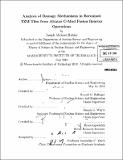| dc.contributor.advisor | Ronald G. Ballinger, Dennis G. Whyte and Bruce Lipschultz. | en_US |
| dc.contributor.author | Hubley, Joseph Michael | en_US |
| dc.contributor.other | Massachusetts Institute of Technology. Dept. of Nuclear Science and Engineering. | en_US |
| dc.date.accessioned | 2011-05-09T15:21:50Z | |
| dc.date.available | 2011-05-09T15:21:50Z | |
| dc.date.copyright | 2010 | en_US |
| dc.date.issued | 2010 | en_US |
| dc.identifier.uri | http://hdl.handle.net/1721.1/62698 | |
| dc.description | Thesis (S.M.)--Massachusetts Institute of Technology, Dept. of Nuclear Science and Engineering, 2010. | en_US |
| dc.description | Cataloged from PDF version of thesis. | en_US |
| dc.description | Includes bibliographical references (p. 83-85). | en_US |
| dc.description.abstract | Alcator C-Mod is a deuterium tokamak reactor experiment operated by the MIT Plasma Science and Fusion Center. Following the 2008 Alcator C-Mod campaign, the reactor was shut down and opened for maintenance and upgrades. During this time, it was discovered that the boronized TZM tiles, with boron films applied in situ, lining the inner surfaces of the reactor had experienced non-uniform damage as a result of plasma interactions. This damage was most pronounced in the tiles from the limiter and divertor, but also appeared in regions of the reactor that were not traditionally believed to experience high heat or particle fluxes. The objective of this thesis is to perform a thorough microstructural analysis of these tiles, particularly the boron-TZM interface, in order to explore the damage mechanisms present. In turn, the details of the damage mechanisms will illuminate the plasma parameters, such as temperature and particle flux, that caused the damage. This analysis will also allow for a prediction of the behavior of other tile and coating materials under consideration for use in fusion devices. During this investigation, a number of tiles with varying degrees of apparent damage were removed from the limiter and divertor and photographed for macroscopic characterization. Modeling was also performed using the expected heat and particle fluxes at the tile surface, along with the thermal transient history of the tiles, to estimate the depth of damage from each of these sources. These results were compared to data gathered during analysis of the tiles through several techniques, including ion beam analysis, scanning electron and optical microscopy, energy dispersive X-ray spectroscopy, and X-ray diffraction spectroscopy. Ultimately, the diverse sets of data gathered through these techniques provided for a fairly cohesive rationalization of the damage mechanisms present. In the case of the divertor tiles, no thermal damage was observed, but the boron film was eroded through sputtering as a result of the large fluxes of high energy particles encountered in that region of the reactor. Tiles in the limiter, however, experienced a more severe amount of damage caused primarily by thermal effects. The surface temperatures at these tiles were in the range 2140-2600 degrees Celsius, surpassing the melting point of boron and approaching that of the underlying TZM. Recrystallization of the TZM substrate was observed to an average depth of -20m, with an overall observed heat penetration depth of -100m. These temperatures indicate a local heat flux of ~108- 109W/m 2 when applied to the heat diffusion model used earlier in this investigation. Such a large heat flux indicates a transient event responsible for the observed damage, occurring on a timescale of milliseconds rather than the one second duration of a pulse at peak power. This transient would be characterized by an increase by an order of magnitude of the product of the plasma density and sheath temperature. Another possibility is that the beads which formed on the melted surface extended beyond the plasma Debye length and intersected the magnetic field lines, resulting in an increase in the heat fluxy by an order of magnitude at those locations. It is difficult to separate the contributions of these damage mechanisms from data obtained after a full Alcator campaign, and further investigation is warranted to better understand each of these processes. | en_US |
| dc.description.statementofresponsibility | by Joseph Michael Hubley. | en_US |
| dc.format.extent | 85 p. | en_US |
| dc.language.iso | eng | en_US |
| dc.publisher | Massachusetts Institute of Technology | en_US |
| dc.rights | M.I.T. theses are protected by
copyright. They may be viewed from this source for any purpose, but
reproduction or distribution in any format is prohibited without written
permission. See provided URL for inquiries about permission. | en_US |
| dc.rights.uri | http://dspace.mit.edu/handle/1721.1/7582 | en_US |
| dc.subject | Nuclear Science and Engineering. | en_US |
| dc.title | Analysis of damage mechanisms in boronized TZM tiles from Alcator C-Mod fusion reactor operations | en_US |
| dc.title.alternative | Analysis of damage mechanisms in boronized titanium, zirconium, molybdenum tiles from Alcator C-Mod fusion reactor operations | en_US |
| dc.type | Thesis | en_US |
| dc.description.degree | S.M. | en_US |
| dc.contributor.department | Massachusetts Institute of Technology. Department of Nuclear Science and Engineering | |
| dc.identifier.oclc | 714526157 | en_US |
